History
The starting date of construction on the castle is unclear, though the first documented evidence originates from the late 12th century. Archeological digs in the interior of the castle complex have so far produced no concrete evidence of a founding in the Early Middle Ages.
In 1185 Vilseck was first mentioned as a part of the Prince-Bishopric of Bamberg. One document from 1205 mentioned a Megelaus of Dagestein, and after the Dagestein dynasty died out, the lords of the Dagestein castle began to use the name of the burgeoning city of Vilseck. In the 15th century the complex was converted into a water castle. During the feud between Götz von Berlichingen (Götz of the Iron Hand) and the Roman Catholic Archdiocese of Bamberg, the castle was sacked and plundered, after which it was again rebuilt. In 1552 the castle was conquered by Albrecht Alcibiades, Margrave of Brandenburg-Kulmbach and thereafter used primarily as a granary and prison. Around 1730 large scale reconstruction occurred, and on the heels of secularization, parts of the castle were sold off to citizens of Vilseck. In the years 1796-7 the bandit leader Franz Troglauer was held prisoner in the castle for several months. Today the castle is owned by the city, with extensive renovations of the keep occurring between 1999 and 2002.

Vilseck is a town in the Oberpfalz region of northeastern Bavaria, Germany, situated on the river Vils, a tributary of the Naab river.

Enceinte is a French term that refers to the "main defensive enclosure of a fortification". For a castle, this is the main defensive line of wall towers and curtain walls enclosing the position. For a settlement, it would refer to the main town wall with its associated gatehouses, towers, and walls.

The Bundesstraße 85 runs southeast through Thuringia and Bavaria, from Kyffhäuser to Passau, near the Austrian border. B85 is approximately 500 kilometers (310 mi) long.

Königstein, also referred to as Königstein (Oberpfalz) to distinguish it from other places named Königstein, is a market town in the Amberg-Sulzbach district, Bavaria, Germany. It is located 45 kilometres (28 mi) NE of Nuremberg.
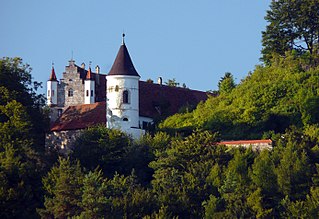
Schloss Neidstein is a castle located in the Upper Palatinate in Bavaria, Germany, in the municipality of Etzelwang.

Hohenwang is a ruined castle in Municipality of Langenwang, Styria, Austria. It stands on a hill at an elevation of 650 metres above sea level.
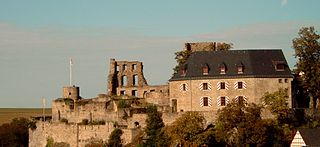
Kastellaun Castle is a ruined medieval castle in Kastellaun in the Rhein-Hunsrück district in Rhineland-Palatinate, Germany.

"Zwinger" is a German word for outer ward or outer bailey. It represents an open kill zone area between two defensive walls that is used for defensive purposes. Zwingers were built in the post-classical and early modern periods to improve the defence of castles and town walls. The term is usually left untranslated, but is sometimes rendered as "outer courtyard", presumably referring to the subsequent role of a Zwinger as a castle's defences became redundant and it was converted into a palace or schloss; however, this belies its original purpose as a form of killing ground for the defence. The word is linked with zwingen, "to force", perhaps because the Zwinger forced an enemy to negotiate it before assaulting the main defensive line. Essenwein states that the "main purpose of this feature was so that the besieging force could not reach the actual castle wall very easily with battering rams or belfries, but had to stop at the lower, outer wall; also that two ranks of archers, behind and above one another, could fire upon the approaching enemy".

Wellheim Castle is a former fortification in Upper Bavaria. The ruins of the old rock castle stand dominantly on Jurassic rocks above the market town of Wellheim in the ancient Danube valley. It was abandoned in the 18th century and partially demolished.

Falkenstein Castle, also called New Falkenstein (Neu-Falkenstein), is a ruined hill castle at 450 m above sea level (NHN) in the eponymous climatic spa of Falkenstein, a quarter of Königstein im Taunus in the county of Hochtaunuskreis in the German state of Hesse.

Mildenstein Castle, in German Burg Mildenstein, also called Schloss Leisnig, is located in Leisnig in Landkreis Mittelsachsen, Saxony, Germany. It is a property of the Free State of Saxony and is administrated by the company State Palaces, Castles and Gardens of Saxony.

The Rauschenburg, also called Rauschenburg Castle, is the medieval ruin of a hill castle, located at around 250 metres above sea level, above the Ehrbach stream in the parish of Mermuth in the county of Rhein-Hunsrück-Kreis in the German state of Rhineland-Palatinate.

Gößweinstein Castle, also called Schloss Gößweinstein, is a mediaeval hilltop castle in Gößweinstein in the county of Forchheim in the German state of Bavaria. It towers high above the market town and the River Wiesent and may have been the inspiration for Richard Wagner's grail castle in his opera, Parsifal. The castle is a Bavarian listed building, no. D-4-74-129-10.

Leienfels Castle was a late mediaeval aristocratic castle, immediately northwest of the eponymous village of Leienfels in the region of Franconian Switzerland in Germany. The village belongs to the borough of Pottenstein in the Upper Franconian county of Bayreuth in Bavaria.
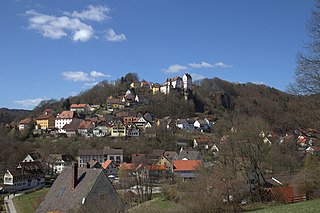
Egloffstein Castle is a former high mediaeval, aristocratic castle, that stands immediately west of the eponymous village of Egloffstein in the Upper Franconian county of Forchheim in the German state of Bavaria.
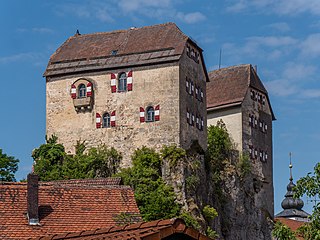
Hiltpoltstein Castle was originally a high mediaeval aristocratic castle dating to the 11th or 12th century. It stands in the centre of the market village of Markt Hiltpoltstein in the Upper Franconian county of Forchheim in the south German state of Bavaria. Its present appearance as a triple-winged building goes back to renovations carried out at the end of the 16th century.
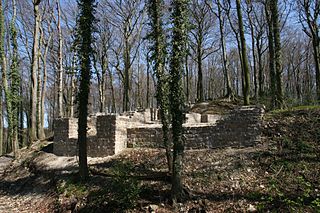
The Holter Burg is the oldest castle site in the municipality of Bissendorf near Osnabrück in the German state of Lower Saxony. It is the ruin of a hill castle. It was the third hill castle in Osnabrück Land along with the Iburg and the Wittekindsburg near Rulle.

Limberg Castle is a ruined hill castle on the 190-metre-high Limberg in the Wiehen Hills. It is located near the village of Börninghausen in the borough of Preußisch Oldendorf in the East Westphalian county of Minden-Lübbecke in the German state of North Rhine-Westphalia.
Georg Ulrich Großmann is a German art historian. He was general director of the Germanisches Nationalmuseum in Nuremberg.




















